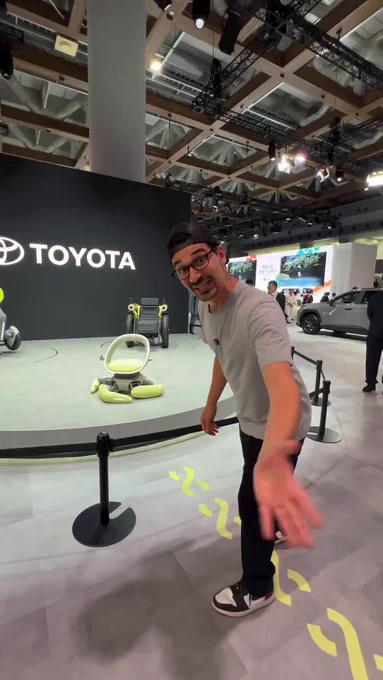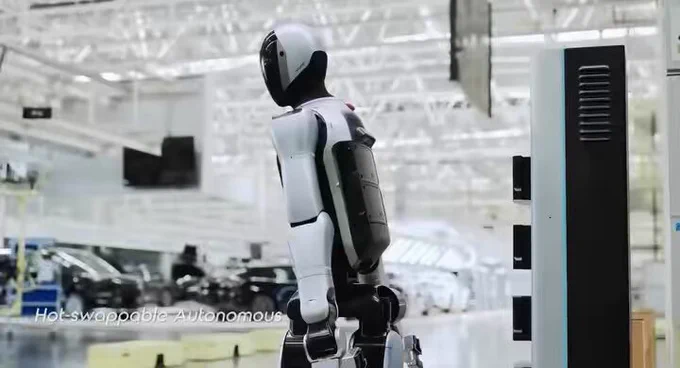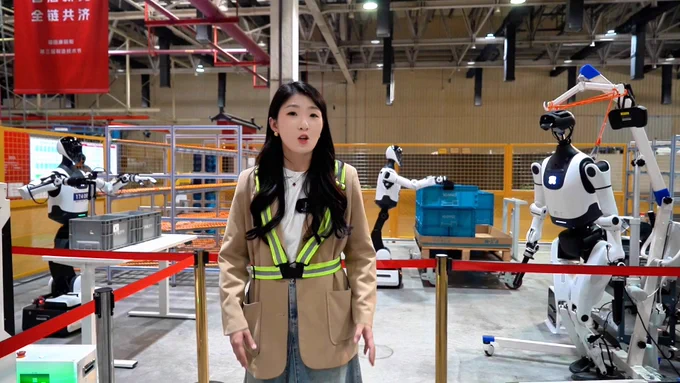Robot: A machine that can be autonomous or semi-autonomous & designed to perform a task either guided by an external control device or by a embedded control.
Nampa, Idaho
Joined November 2017
- Tweets 9,193
- Following 606
- Followers 573
- Likes 654
ROBOTS retweeted
a different vibe.
what would happen if they actually met?
the prototype of Optimus V3 is set to be unveiled next year,and it might just be breathtaking.
ROBOTS retweeted
Here is closer look at @XPengMotors humanoid robot.
It can be fully automated or teleported.
Looks and feels (yes I touched it haha) amazingly. I am proud to be an Xpeng car owner and supporter. They are innovating incredibly quickly by pushing forward exciting tech!
ROBOTS retweeted
Another humanoid robotics startup, Norway-based Physical Robotics, is out of stealth.
The company was founded by Phuong Nguyen, a co-founder of Halodi Robotics (now rebranded as 1X Technologies). He was Chief Science Officer at Halodi for eight years, leading the development of the EVE robot.
The new company's mission is to “create a generation of robots that live in harmony with humans in the physical world, enhancing the quality of human life.”
Last week, the company announced the closing of a $4 million seed round. Here's the upper body concept of their humanoid, the π robot.
ROBOTS retweeted
Robot dogs join firefighting crews! 🧯
In Sichuan, China, a quadruped robot just joined the firefighting team.
Deployed on the front lines, the robot assisted crews by scouting hot zones, carrying hoses, and operating in hazardous areas that would normally put responders at risk.
The quadruped platform combines mobility, thermal imaging, and remote operation to navigate unstable terrain and deliver real-time situational awareness.
Firefighting may be one of the toughest environments for automation, but every safe mission proves the same point: robots belong where humans shouldn’t have to go.
The NAVIAI robot from the Zhejiang Humanoid Robot Innovation Center showcased over 10 practical skills at the "Pioneering Future Embodied Intelligence Validation Field". The demonstration highlights its potential to revolutionize both production and daily life by acting as a productive and domestic assistant.
In manufacturing, NAVIAI can intelligently automate the full process in garment factories, handling fabric identification and sewing startup with a deviation controlled within 2mm. In 3C coating workshops, it performs precise operations with end repeatability accuracy of 0.1mm, safely mitigating chemical contamination risks.
Its capabilities extend to labs, where it automates long workflows, achieving precise liquid transfer from 1mL to 500mL using fluid control algorithms. Beyond industrial work, NAVIAI is demonstrated as a personal butler that can manage household chores, care for daily needs, and even prepare meals.
Finally, the robot is shown operating in autonomous robot supermarkets, where it independently handles item location, identification, grasping, and delivery, ensuring 24-hour service availability.
#humanoid #robotics #automation #homerobot
A new deep-dive report on the humanoid robot market suggests that wheeled forms will achieve commercial deployment before their bipedal counterparts. While most companies are focused on bipedal robots (52% of new releases in H1 2025 vs. 44% for wheeled), the report highlights three key advantages for wheeled robots.
Here's why they're poised to lead commercialization:
► Training Difficulty: Wheeled robots are far easier to train, as they rely on simple locomotion and avoid the complex gait planning and dynamic stability required for bipedal forms.
► Cost: With their simpler structure, wheeled robots are significantly cheaper to manufacture and maintain. The BOM cost for a pair of bipedal legs can be ten times higher than a wheeled base of the same height.
► Battery Life: Wheeled robots offer much longer battery life, often running for over 5 hours compared to less than 2 hours for most bipedal models.
The report concludes that for most current applications, a stable, fast base with a dexterous upper body is what's needed for tasks like logistics, healthcare assistance, and retail. This makes wheeled robots a more immediate and practical fit for market demands.
ROBOTS retweeted
1X has opened orders for the NEO humanoid in the US: $20k for owning a NEO or $499/month for subscription.
An order can be secured with a $200 fully refundable order deposit.
Users will be able to schedule a chore or command NEO to do a task in real-time, or have a conversation. For any chore that NEO doesn't yet know, owners can schedule a “1X Expert” (remote operator physically present in the USA) to guide it through unknown tasks.
US deliveries begin in 2026, starting with customers choosing to own NEO outright with $20k.
AeiROBOT Launches ALICE 4 Humanoid Platform
Korean company AeiROBOT introduced ALICE 4, a 160 cm, 45 kg humanoid platform with 41 degrees of freedom. Its core feature is a proprietary, gear-free linear actuator technology.
This actuator design delivers ultra-quiet, energy-efficient operation with precise force control and low inertia, optimizing dynamic performance. The robot is powered by Jetson Orin NX computing and features FSR sensors, IMU, and a depth camera for stable control and natural interaction.
ROBOTS retweeted
First impressions of @1x_tech neo robot, as a mechanical engineer that got to see it for the first time yesterday
- It’s lighter than i expected. Only 66 pounds and @radbackwards even let me pick it up! (which was easy for me because i’m strong)
- This short king can lift 150 lbs and carry 55 lbs!
- I loved the soft body panels. the robot has a softness to it that definitely makes it feel safe. They use a compliant plastic lattice which i assume was picked to still allow convective cooling. I really hope other humanoid companies adopt this.
- It looks fresh as hell wearing my pit vipers
- The knit sweater is good at minimizing pinch hazards. I wasn’t a fan of how it looked in the past but the new soft body panels fill out the frame and make it look warm and inviting
Overall, big fan of the form factor and the soft padding. Good job @BerntBornich and team, best of luck!
ROBOTS retweeted
Optimus at Time Square this morning giving out candies to the public while being tethered to a charger.
Elon Musk thinks Optimus can achieve 5x the productivity of a person per year because it can operate 24/7 while tethered.
ROBOTS retweeted
The world’s first humanoid robot that changes its own batteries and never dies..
My fellow humans, it’s been fun.
Three of these companies, LimX, EngineAI, and UBTECH are from Shenzhen, and there are definitely more not listed here.
TienKung Robot Officially Starts Work at Foton Cummins Factory!
Humanoid Marathon Champion "TienKung" Enters the Factory
At IROS 2025, the Beijing Humanoid Robot Innovation Center (BHRIC) and UBTECH officially launched the Software Development Kit (SDK) for their general-purpose embodied intelligence platform, "HuiSiKaiWu." This move signals a significant step towards an open-source embodied AI ecosystem.
The HuiSiKaiWu platform is designed for ease of use and low-threshold deployment, enabling multi-agent collaboration (one brain, multiple functions/robots). The core "brain" uses a dual-model architecture: the Pelican VLM and the WoW World Model, driving autonomous learning and decision-making. The "cerebellum" includes the cross-body XR-1 VLA Model, which has shown strong performance in rapid, few-shot skill transfer across tasks.
BHRIC simultaneously announced its first industrial application: since September 2025, the "TienKung 2.0" and "Tianyi 2.0" humanoids have been deployed at the Foton Cummins engine factory. They autonomously handle material bin fetching and transportation on the "unmanned production line," adapting to various goods and shelf heights. Foton Cummins highlighted the robots' high stability and generalization potential in complex industrial processes.
Beyond industrial work, BHRIC showcased other applications: the high-performance "TienKung Ultra" is being used at the Li-Ning Sports Science Lab for running shoe tests, precisely simulating human gaits. The platform is expanding applications across manufacturing, logistics, and sports science.
The HuiSiKaiWu SDK is now available for collaborative trials by research institutions and development teams, offering a full toolchain for skill calling and scene deployment. BHRIC plans to gradually open-source its core algorithms, including VLM and VLA models, and hosted the "X-Humanoid Young Talent Meetup" and the "2026 Re-Action Humanoid Robot Challenge" to build a comprehensive developer ecosystem.
ROBOTS retweeted
Even when humans playfully play with the humanoid robot,it patiently waits until the empty cup is actually placed before it.
A test: A staff member frequently interrupts the robot to see if Astribot S1 can recognize the empty cup until it correctly selects it, picks it up, and autonomously fills it with popcorn, all in one go.
A simple human action is difficult for a humanoid robot (AI). In real-world situations, with many uncertain environmental distractions, such as a crowded table, unprocessed order labels, and an empty cup, a humanoid robot must make precise decisions and actions to be truly effective.
P.S. You can try Optimus next time you're at the Tesla Diner.
VLAI Robotics Launches High-Dexterity Dual-Arm Robot Starting at ~$5,500 USD
VLAI Robotics, utilizing the open-source design of Japan’s OpenArm team, has introduced a high-dexterity, low-cost bimanual robotic system. The product is priced from 39,900 RMB (approximately 5,500 USD), making high-level research tools accessible to institutions and developers.
The robot features a human-scale, arm-hand integrated design with up to 16 DOF (8 DOF per arm, including the gripper). It can handle a dual-arm peak payload of 12 kg while maintaining high precision. A key breakthrough is its ability to replicate human upper limb movement trajectories, which enhances data quality for imitation learning and remote operation.
VLAI Robotics handled the domestic engineering, manufacturing, and VLA (Vision-Language-Action) algorithm integration, with quality control organized according to the strict standards of the OpenArm R&D framework. The robot is highly adaptable for research, education, and Physical AI training, supporting easy expansion for features like VR teleoperation.











































